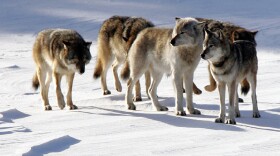A wolf that fled from Isle Royale National Park over an ice bridge was found dead on the Minnesota mainland last month.
Researchers were unsure how the wolf died at the time, but a necropsy found that the five-year-old female wolf was shot with a pellet gun.
Lee Berquist of the Milwaukee Journal-Sentinel has more:
Although it's not known who shot the wolf or where, the animal was "likely shot by someone trying to scare it away," said Liz Valencia, park service chief of interpretation and cultural resources at Isle Royale National Park. Valencia said such a shooting did not violate tribal regulations and she was not aware of any investigation or pending charges over the animal's death.
Michigan Technological University researchers who study Isle Royale’s wolves and moose say the female wolf, known as Isabelle, was a loner on Isle Royale. She had been attacked by other wolves on the island before escaping over the ice bridge this winter.
Researchers last spotted Isabelle on the shoreline of Isle Royale on January 21 during a research flight.
From their blog:
A lone wolf traveling on the ice. And, she was wearing a radio-collar. It’s Isabelle. She has survived to see another winter. Amazing. Last year Isabelle was nearly killed on at least two occasions in attacks by the female of the West-end Trio. As a lone wolf, she also had difficulty getting food. Freedom from the social bonds of living in a pack comes with a steep cost… As we circled Isabelle, every few moments she stopped and turned to look back, as though concerned about being followed by other wolves. We knew what she likely did not: at the moment she was safe from her mortal enemy, who was miles away on the other side of the island. Then again, she certainly knows a great deal that we do not.
John Flesher of the Associated Press has more on what might have happened to the female wolf after that sighting:
She may have veered across the ice that night. At age 3, she had left the pack into which she was born, which is normal behavior for a wolf, Peterson said. "They disperse and look for vacant territory and an opportunity to mate," he said. "But she's been trapped on Isle Royale. She'd been traveling on her own for two years and never had pups."
Researchers on Isle Royale National Park have been following the interactions between wolves and moose for more than 50 years. The island is home to the longest continuous predator-prey study in the world, and researchers and fans of the study are worried about the number of wolves left on the island.
At last count, there were just nine adult wolves left. That’s down from a peak of 50 animals in the late 1970s. Researchers will release a more up-to-date tally of the number of wolves left on Isle Royale in the coming weeks.
Isle Royale National Park Superintendent Phyllis Green is gathering information on whether the park service should bring in new wolves or not. You can read more about that here.









